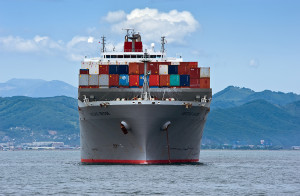It is no exaggeration to say that our life depends on freight transport. It does. But how can we reconcile the need to reduce shipping volumes (in view of climate change) with the need for more shipping (partly because the world population is constantly growing)?
These thoughts dominated the opening of this year’s Transportforum. A single day without functioning shipping and you would see rubbish piled in the streets, empty store shelves, and a lack of clean sheets at our hospitals – to cite just a few examples.
Jean-Paul Rodrigue is a professor who studies maritime shipping and container traffic at Hofstra University in New York. He was invited to be a guest lecturer along with Ikea Global Purchasing Manager Maria Andersson.
In terms of volume, 90% of the world’s trade travels by sea. The corresponding figure in terms of value is just over 70%.
Maritime shipping is a global industry that is very confusing, according to Rodrigue. The vessels are built in China, owned by Greeks and Japanese, registered in Panama, managed by Danes and Swiss, while the bulk of the shipments pass back and forth between countries in Asia, such as India and Pakistan.
Container vessels are getting bigger and bigger. The biggest ones can transport 20,000 containers at a time.
“It’s frustrating that the vessels are so big”, says Rodrigue. “The harbours constantly have to be rebuilt to accommodate them”.
Maritime shipping companies are owned by private interests that favour large vessels in order to keep their shipping costs down and maximise profits. The harbours, however, are usually owned by individual nations.
“The harbours are built with tax money. The private [ship] owners make money while the taxpayers in various countries serve up good infrastructure. I think that’s a problem”.
Rodrigue says that big ships are justified when shipping large volumes, but it is often impossible, for various reasons, to ship volumes that are as large as one wants. Smaller container vessels would therefore make more sense in many cases.
“And then the harbours would not have needed to expand to the extent they have. In a general sense, every single harbour in the entire world is over-invested”.
Maria Andersson of Ikea purchases the shipping services that the company requires globally. With 262 department stores in Europe, 52 in the USA and Canada, 40 in Asia, 12 in the Middle East, and eight in Australia, anyone can see that Ikea products add up to a lot of shipments.
“Ikea is one of the companies that ships the most goods in the world”, notes Andersson.
This also explains all of Ikea’s flat packages: it takes less space to ship a sofa in three pieces rather than one. Every little centimetre that can be filled with cargo saves the company money, and benefits the environment. Hopefully.
“We are also trying to reduce the weight of our goods. That’s why we work closely with the designers right from the start”.
According to Andersson, the shipping capacity on the world’s oceans exceeds demand. But the fact that maritime shipping is so global makes it difficult to influence individual shipping lines to customize their business practices.
“Maybe we choose one shipping line for environmental reasons, but the goods may very well be shipped by another line in any event, because the two are working in cooperation with one another. If you want to influence maritime shipping, many buyers have to come together, and the initiative has to be global”.
This article is a report from the VTI conference Transportforum 2016. You find more information about the conference here (in Swedish).








Follow us: